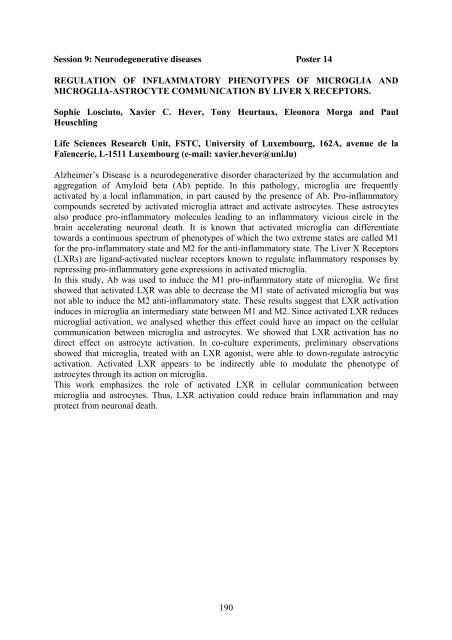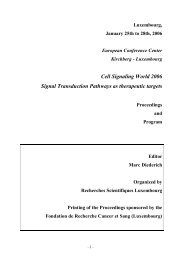Abstract book (download .pdf file) - Redox and Inflammation ...
Abstract book (download .pdf file) - Redox and Inflammation ...
Abstract book (download .pdf file) - Redox and Inflammation ...
Create successful ePaper yourself
Turn your PDF publications into a flip-book with our unique Google optimized e-Paper software.
Session 9: Neurodegenerative diseases Poster 14<br />
REGULATION OF INFLAMMATORY PHENOTYPES OF MICROGLIA AND<br />
MICROGLIA-ASTROCYTE COMMUNICATION BY LIVER X RECEPTORS.<br />
Sophie Losciuto, Xavier C. Hever, Tony Heurtaux, Eleonora Morga <strong>and</strong> Paul<br />
Heuschling<br />
Life Sciences Research Unit, FSTC, University of Luxembourg, 162A, avenue de la<br />
Faïencerie, L-1511 Luxembourg (e-mail: xavier.hever@uni.lu)<br />
Alzheimer’s Disease is a neurodegenerative disorder characterized by the accumulation <strong>and</strong><br />
aggregation of Amyloid beta (Ab) peptide. In this pathology, microglia are frequently<br />
activated by a local inflammation, in part caused by the presence of Ab. Pro-inflammatory<br />
compounds secreted by activated microglia attract <strong>and</strong> activate astrocytes. These astrocytes<br />
also produce pro-inflammatory molecules leading to an inflammatory vicious circle in the<br />
brain accelerating neuronal death. It is known that activated microglia can differentiate<br />
towards a continuous spectrum of phenotypes of which the two extreme states are called M1<br />
for the pro-inflammatory state <strong>and</strong> M2 for the anti-inflammatory state. The Liver X Receptors<br />
(LXRs) are lig<strong>and</strong>-activated nuclear receptors known to regulate inflammatory responses by<br />
repressing pro-inflammatory gene expressions in activated microglia.<br />
In this study, Ab was used to induce the M1 pro-inflammatory state of microglia. We first<br />
showed that activated LXR was able to decrease the M1 state of activated microglia but was<br />
not able to induce the M2 anti-inflammatory state. These results suggest that LXR activation<br />
induces in microglia an intermediary state between M1 <strong>and</strong> M2. Since activated LXR reduces<br />
microglial activation, we analysed whether this effect could have an impact on the cellular<br />
communication between microglia <strong>and</strong> astrocytes. We showed that LXR activation has no<br />
direct effect on astrocyte activation. In co-culture experiments, preliminary observations<br />
showed that microglia, treated with an LXR agonist, were able to down-regulate astrocytic<br />
activation. Activated LXR appears to be indirectly able to modulate the phenotype of<br />
astrocytes through its action on microglia.<br />
This work emphasizes the role of activated LXR in cellular communication between<br />
microglia <strong>and</strong> astrocytes. Thus, LXR activation could reduce brain inflammation <strong>and</strong> may<br />
protect from neuronal death.<br />
190




